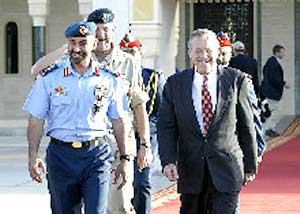After talks with the UAE's defense minister and chief of staff, Rumsfeld and Franks said U.S. military forces were not going to leave the Persian Gulf region any time soon. "We assured them that the United States intends to do what is necessary to make sure there is a secure environment in Iraq," Rumsfeld said. "There's no question but that the people of this region are safer today than they were when the Saddam Hussein regime was in power." Rumsfeld is in the region to meet with U.S. troops involved in the war in Iraq and to discuss America's role after overthrowing Saddam. He also plans to see government leaders and U.S. troops in Afghanistan later in the week. The defense secretary has said the United States is considering reducing or rearranging its presence in the Persian Gulf region now that the threat from Iraq is over. But Franks, head of the U.S. Central Command, said a possible reduction in the American use of ports and air bases in the UAE did not come up Sunday. He said the issues needs more study. Franks said the U.S. military presence in the region might increase, at least in the short term, as stability and humanitarian relief missions in Iraq and Afghanistan continue. Rumsfeld and Franks said they are pleased with progress in the search for top members of Saddam's government. Ordinary Iraqis are a big help, Franks said. "They want these people out of their country," the general said. U.S. forces announced Sunday they had captured Lt. Gen. Hossam Mohammed Amin, Saddam's chief contact with U.N. weapons inspectors. Amin was No. 49 on the U.S. list of 55 most wanted Iraqis. His capture brings to 13 the number of officials on that list whom U.S. officials have acknowledged as being in custody. Iraq's former deputy prime minister, Tariq Aziz, seems to be cooperating with his American interrogators, but his claims must be checked to see if they are true, Franks said. Aziz surrendered to U.S. forces in Baghdad on Thursday. "How cooperative and how truthful he is, we'll have to see over time," Franks said. He said the United States will have to search several thousand sites for evidence of Iraq's chemical, biological and nuclear weapons programs. American forces started the war with a list of about 1,000 suspect sites, and for each site on the list, Iraqis tell Americans about one or two others, Franks said.
|
